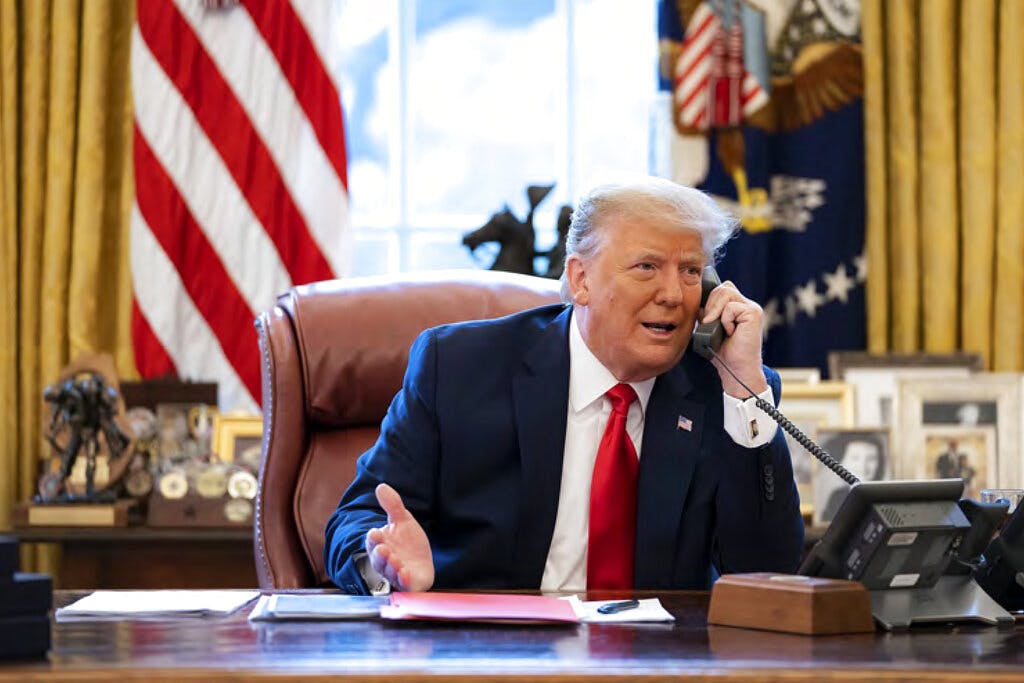Doubt Grows Over Whether Potential Trump Charge Is Constitutional
A law born out of Enron’s collapse comes of age in January 6 prosecutions.

As the Department of Justice’s investigation into the events of January 6 eclipses the two-year mark, the work to indict President Trump as responsible for what transpired that day in 2021 is well under way.
One cheat sheet for such an effort could be the four criminal referrals proffered to the DOJ by the January 6 committee: obstruction of an official proceeding; conspiracy to defraud the U.S.; conspiracy to make a false statement; and inciting an insurrection.
One knot that the special counsel, John “Jack” Smith, who inherits the inquest into Mr. Trump’s behavior, will have to untie is whether that first crime — obstruction of an official government proceeding — is appropriate for the former president’s behavior that day.
So far, despite a legal fit that is less than airtight, the obstruction count is being deployed, ensnaring in its January 6 dragnet everyone from the so-called QAnon Shaman, Jacob Chansley, to the leader of the Oath Keepers, Elmer Stewart Rhodes, to an Olympic swimmer, Klete Keller.
The rule targets “whoever corruptly … obstructs, influences, or impedes any official proceeding,” as well as anyone who “alters, destroys, mutilates, or conceals a record, document, or other object, or attempts to do so, with the intent to impair the object’s integrity or availability for use in an official proceeding.”
An auxiliary statute defines “official proceedings” as those before federal judges, Congress, federal government agencies, and regulators of insurance businesses. The crime carries a maximum prison sentence of 20 years.
The charge has so far been leveled at more than 250 defendants, making it one of the government’s primary tools in its sprawling portfolio of prosecutions. Its deployment has been rocky, struggling against judicial skepticism at its expansive purview.
The law was enacted by the might of the Sarbanes-Oxley Act of 2002, passed amid the implosions of Enron and WorldCom. It specifically responded to the behavior of Enron’s auditor, Arthur Andersen, who destroyed potentially incriminating documents.
Andersen was prosecuted under an older, more cramped version of the law, and his district court conviction was eventually overturned by the Supreme Court, which ruled that jury instructions that omitted that the crime must be committed not only “corruptly” but also “knowingly” were defective. The statute’s current iteration erases such hairsbreadth distinctions.
That broadness is manna for prosecutors but sets off alarm bells for judges, for whom vagueness in criminal law is a fatal constitutional flaw that violates the due process clauses of the Fifth and Fourteenth Amendments.
January 6 defendants have argued that the Electoral College’s counting of the vote — the proceeding that was disrupted — is not the kind of event contemplated by the statute, because it is ceremonial rather than an occasion for the presentation of evidence
In a trial involving the leaders of the Oath Keepers militia, Judge Amit Mehta of the Federal District Court for the District of Columbia pushed prosecutors to draw the line between less severe yet still interruptive offenses and this stricter statute.
The judge worried that it was a “real problem” for prosecutors to “suggest, ‘We know it when we see it, and we’ll pick and choose when it is an appropriate exercise of prosecutorial discretion.’”
The assistant United States attorney arguing the case, Jeffrey Nestler, staked out a different position, arguing that the obstruction statute was meant to cover “matters not specifically contemplated” when the law was enacted because law enforcement needs the tools to match “inventive criminal minds.”
As the Washington Post reports, Judge Mehta’s skepticism that the law was being unduly stretched was shared by his colleague on the bench, Randolph Moss. Both judges cite a 2015 Supreme Court decision that scotched the conviction of a Florida fisherman, John Yates, for destroying 69 undersize fish, impeding wildlife inspectors investigating the legality of his marine haul.
Yates was convicted for violating Sarbanes-Oxley, specifically its provision against destroying “any record, document or tangible object.” The justices held that a fish — Epinephelus morio, or red grouper, in this case — was not a “tangible object” as contemplated by the law.
Justice Ruth Bader Ginsburg, announcing the majority’s opinion, noted, “Fish one may fry but may one falsify, or make a false entry in the sea dwelling creatures?” Justice Elena Kagan dissented, writing that “a fish is, of course, a discrete thing that possesses physical form.”
Yet another district judge at the District of Columbia, Dabney Friedrich, ruled that despite the obstruction charge’s roots in Sarbanes-Oxley and financial crime, “statutes often reach beyond the principal evil that animated them,” if not quite so far as into the pellucid waters of the Atlantic Ocean.

